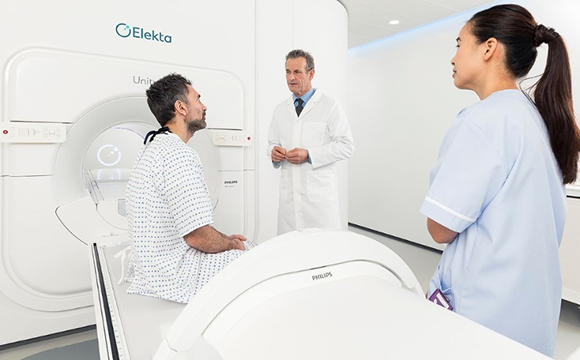One of the deadliest cancers worldwide
Pancreatic cancer remains one of the most aggressive and challenging cancers, with an overall five-year survival rate of 10% globally. As incidence rises globally, reaching 18.6 cases per 100,000 people by 2050, the need for effective, personalized treatment is more urgent than ever.1
Adaptive radiotherapy enables safe dose escalation and motion management, offering hope where surgery is not possible.2
Globally only
people survive five years
Proven precision, stronger local control
Key clinical studies demonstrate that adaptive radiotherapy delivers precise, high-dose treatment safely, achieving meaningful local control and quality of life in pancreatic cancer.
Daily adaptation for pancreatic motion
The pancreas can move up to 43 mm between treatments, making MR- and CT-guided adaptive radiotherapy essential for accurate, safe dose delivery, even in palliative or locally advanced cases.3
High local control with MR-guided adaptive radiotherapy
MR-guided adaptive radiotherapy achieves over 90% local tumor control at 1 year, helping stabilize disease and reduce symptoms in patients with unresectable pancreatic cancer.4
Meaningful survival with 5-fraction treatment
Five-fraction MR-guided adaptive schedules have demonstrated around 40% 2-year survival, showing potential to improve both survival and quality of life.5
How adaptive radiotherapy helps you respond to clinical changes
| Your challenge | Adaptive helps you... |
| Pancreas shifts 4–5 cm during breathing | Manage respiratory motion and reoptimize the plans daily to stay on target. |
| GI proximity limits safe dose escalation | Spare the duodenum, stomach, and bowel with daily plan re-optimization. |
| Limited time or planning resources | Use streamlined plan-of-the-day/adaptive workflows to reduce re-planning overhead and keep throughput predictable. |
| Longer courses take time patients don't have | Use hypofractionated schedules (e.g., five sessions) when clinically appropriate to cut visits without adding risk. |
Real progress: Backed by clinics and clinical data
Nobody does adaptive like Elekta
Treating pancreatic cancer demands precision, consistency, and confidence. We don’t just bring imaging to the point of treatment, across MR- and CT-guided linacs, we also provide the training, partnership, and expertise to help you safely escalate dose, manage motion, and deliver care with confidence. Together, we can evolve pancreatic cancer treatment so every patient has access to personalized care when it matters most.

The pancreas challenges every margin
Tumors in the pancreas are surrounded by critical structures like the stomach, duodenum, and bowel, and they move with every breath. Even small shifts can compromise coverage or increase risk to healthy tissue. Adaptive radiotherapy uses daily MR or CT imaging to respond to these changes in real time, helping deliver precise dose where it’s needed while protecting the organs that matter most.
Adaptation that enables you to do more, safely
Adaptive radiotherapy is a next-generation approach that tailors each treatment to the patient’s anatomy in real-time. With daily imaging and on-table adaptation, you can visualize soft tissue, track tumor and organ motion, and adjust the plan before delivery. This level of precision allows you to confidently deliver high-dose radiotherapy near the Gastrointestinal (GI) tract, reducing risk, sparing healthy tissue, and aiming for better outcomes in even the most complex cases:
Aim for meaningful survival gains
Ablative dosing (≥50 Gy) has shown the potential to improve median overall survival beyond the traditional 10–16 months.
Escalate dose safely
Adaptive planning helps reduce GI toxicity by adjusting plans daily. Non-adaptive SBRT reports grade 3–4 toxicity in up to 13% of cases.
Stay on target, protect what matters
Daily plan adaptation accounts for pancreas motion and proximity to organs at risk, helping you maintain full target coverage and avoid overdosing sensitive structures.
Share your thoughts
We're asking how centers are approaching adaptive radiotherapy, where are you on the journey?
1. Why are you interested in content on adaptive radiotherapy?
Delivering the future of pancreatic cancer treatment
Whether you’re treating inoperable tumors, borderline resectable cases, or post-operative recurrences, your patients deserve the most advanced radiotherapy available, delivered precisely, safely, and with long-term outcomes in mind.
With daily imaging, adaptive planning, and efficient workflows, you can escalate dose with confidence, maintains GI constraints while escalating dose, and treat more patients in fewer sessions—without compromising quality or throughput.
Explore our adaptive solutions for pancreatic cancer
Our image-guided adaptive solutions help clinicians deliver safe, precise doses around critical organs such as the duodenum and stomach, improving local control and quality of life for pancreatic cancer patients.
Indications
References
- Cho, J. and Petrov, M.S. (2020) ‘Pancreatitis, pancreatic cancer, and their metabolic sequelae: projected burden to 2050’, Clinical and Translational Gastroenterology, 11(11), e00251. Available at: https://doi.org/10.14309/ctg.0000000000000251
(Accessed: 16 October 2025). - 2025 Global Impact Report. Available at: https://aboutadaptive.com
(Accessed: 16 October 2025). - Ferris, W.S., George, B., Plichta, K.A., Caster, J.M., Hyer, D.E., Smith, B.R. and St-Aubin, J.J. (2024) ‘Clinical experience with adaptive MRI-guided pancreatic SBRT and the use of abdominal compression to reduce treatment volume’, Frontiers in Oncology, 14, 1441227. Available at: https://doi.org/10.3389/fonc.2024.1441227
(Accessed: 16 October 2025). - Erickson, B. et al. (2021) ‘Magnetic resonance guided radiation therapy for pancreatic adenocarcinoma: advantages, challenges, current approaches, and future directions’, Frontiers in Oncology, 11, 628155. Available at: https://doi.org/10.3389/fonc.2021.628155
(Accessed: 16 October 2025). - Kim, H. et al. (2020) ‘Ablative five-fraction stereotactic body radiation therapy for inoperable pancreatic cancer using online MR-guided adaptation’, Advances in Radiation Oncology, 6(1), 100506. Available at: https://doi.org/10.1016/j.adro.2020.06.010
(Accessed: 16 October 2025).


